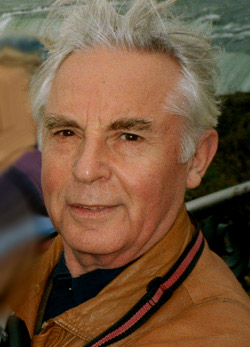Arkady (Abram) Remennik: AUTOBIOGRAPHY
On My Path to Discovering Paper Engraving
Click here to view Paper Engraving examples.
My father was a jeweler and a very qualified watch-maker. After the Great October Revolution he could work only as a watch-maker. He was my first teacher who showed me how to engrave upon silver and copper. I learned to cut with a graver (engraving tool) and different legends in calligraphic style. When I was a grade 10 student, I engraved a self-portrait on a silver plate (see the example on the page below). This engraving technique interested me greatly, and I was instantly attached.
Finally, this interest helped me to make up my mind and I decided to
become an artist. In 1946 I became a student of the Design of Printing
and Publishing Industry Institute. I was sure that it was the right
choice and that I would be able to improve the skills in the area I
was most interested in.
Unfortunately, the University did not have an engraving department so
I had to work independently to learn what I was interested in. I was
lucky to find the only textbook on engraving and techniques that were
available those days (its author was Pavlov).
I myself learned xylography and soon created a project using this technique, it was a set of illustrations for one of the stories by Tchechov, a famous Russian writer. It happened at the end of the second year of my studies, and you can imagine how proud I was when a small book with my engravings was officially published.
When I became a third year student, we got a new teacher in design and drawing. It was Goncharov, who was also famous for his works in xylography. He helped me a lot with approaching technical problems. He also introduced me to Favorsky, the most recognized specialist in xylography. We used to discuss common problems and became good friends. I never gave up contact with him even when he fell into disgrace as the Soviet government had accused him of formalistic distortion of art.
Meanwhile, my skills became stronger and stronger, and I used the same technique for my Thesis Project. My project got the highest mark. None of 44 graduates could do what I did. It was a unique piece of art. It’s interesting to mention that I engraved the piece using my father’s gravers.
After the graduation I worked with the largest publishing houses of Moscow where I often used xylography. I engraved more than 50 portraits of famous writers, artists, and philologists.
But all the time I was researching new ways and new skills and even
new techniques.
In 1956 a group of artists organized an art studio. I was among them,
and we invited Belutin to be a manager of the studio. I worked there
for many years; it was a good school and a laboratory for me. I made
a lot of experiments with different materials and techniques. I tried
to combine drawing and engraving, invented new kinds of gravers, so
that I could cut some drawing on paper and then complete it with water-colors.
I made over 600 portraits and landscapes using this technique. These
experiments lead me to a completely new technique, which I named ”Engraving
upon Paper” and in 1983 I took out a patent from the State Chamber
of Inventions of the USSR. It was the only patent in Fine Art. Two books
designed by me in this technique were published.
Finally, during “Perestroika”, our studio was recognized.
There took place a big exhibition of our works in Manegz Exhibition
Hall in Moscow which was a great success. Some of my works were also
there and moreover two of them were bought by the Union of Artists of
the USSR. It was unbelievable. It was fantastic. My work finally got
wide recognition.
Now I am still working using my techniques and still looking for new
trends in my area.
|
|||||||||||||||||







